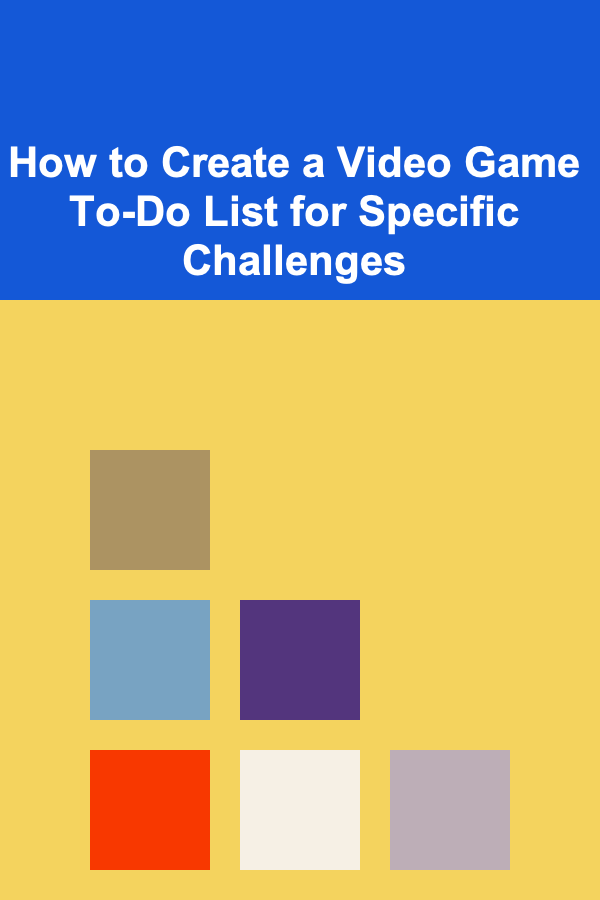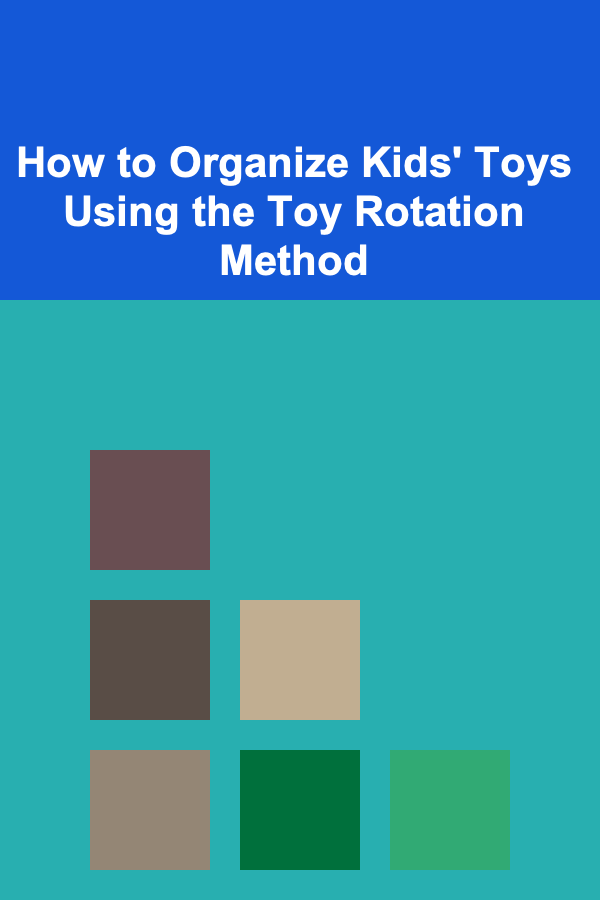
How to Create a Video Game To-Do List for Specific Challenges
ebook include PDF & Audio bundle (Micro Guide)
$12.99$9.99
Limited Time Offer! Order within the next:

Creating a video game is a complex and multifaceted process that involves several stages, from conceptualization to development and testing. A crucial component of ensuring that the process runs smoothly is the creation of a comprehensive to-do list. This list acts as a roadmap for the team, helping to stay organized, manage time effectively, and track progress on specific challenges that arise during the development process.
However, not all to-do lists are created equal. A general to-do list might help you cover the basic aspects of game development, but when tackling specific challenges---whether technical, creative, or logistical---you need a more targeted, focused approach. This article will guide you through the process of creating a specialized to-do list that addresses specific challenges you might face when developing a video game. From feature implementation to debugging, art direction, and balancing gameplay, a targeted to-do list will help ensure your game gets from concept to completion effectively.
Step 1: Identify the Specific Challenges
The first step in creating a video game to-do list for specific challenges is to clearly identify what challenges you face. These challenges will vary depending on the stage of development, the complexity of the game, the size of your team, and the resources available to you.
Types of Common Challenges in Video Game Development
-
Technical Challenges:
- Performance Optimization: Games can sometimes suffer from performance issues, such as frame rate drops or long loading times.
- Cross-Platform Compatibility: Ensuring your game runs smoothly on various platforms (e.g., PC, consoles, mobile devices).
- Network and Multiplayer Issues: Implementing robust online multiplayer features and managing server-client communications can be tricky.
- Bug Fixing: Identifying and resolving technical bugs that hinder gameplay or user experience.
-
Creative Challenges:
- Game Design: Ensuring that the game mechanics, levels, and overall structure provide a fun, engaging experience.
- Story and Narrative Development: Developing a compelling story that aligns with gameplay mechanics and resonates with players.
- Art and Animation: Creating visual assets that match the game's theme and style while ensuring they integrate well with the gameplay.
- Sound and Music: Designing and implementing sound effects and music that enhance the atmosphere of the game.
-
Project Management Challenges:
- Time Management: Meeting deadlines and managing the project scope.
- Team Collaboration: Ensuring effective communication and collaboration between designers, developers, artists, and testers.
- Budgeting: Keeping the project within budget, especially if there are unexpected costs related to software or outsourcing.
Action Step:
- Brainstorm and list down the specific challenges you're likely to encounter based on the current phase of the project and the scope of your game.
- Identify any recurring issues or bottlenecks that may affect your progress.
Step 2: Break Down Each Challenge into Actionable Tasks
Once you've identified the challenges, the next step is to break them down into smaller, actionable tasks. This makes the challenge feel less overwhelming and gives you clear objectives that can be tackled one at a time.
Breaking Down Challenges by Category
-
Technical Challenges:
- Performance Optimization :
- Task 1: Profile the game's performance to identify bottlenecks.
- Task 2: Optimize asset loading times, textures, and meshes.
- Task 3: Implement level-of-detail (LOD) techniques to reduce resource usage.
- Task 4: Test frame rate performance on various hardware configurations.
- Cross-Platform Compatibility :
- Task 1: Identify the target platforms and their specific requirements.
- Task 2: Adjust controls for different input methods (e.g., keyboard, controller, touch).
- Task 3: Test the game on different devices and fix platform-specific bugs.
- Bug Fixing :
- Task 1: Create a bug-tracking system to document reported issues.
- Task 2: Prioritize bugs based on their severity and impact on gameplay.
- Task 3: Perform thorough regression testing after each fix to ensure no new issues arise.
- Performance Optimization :
-
Creative Challenges:
- Game Design :
- Task 1: Define core gameplay mechanics (combat, movement, puzzle-solving, etc.).
- Task 2: Create and test level design prototypes.
- Task 3: Establish progression systems and reward mechanisms.
- Art and Animation :
- Task 1: Create concept art for characters, environments, and assets.
- Task 2: Develop 3D models or sprites for the game.
- Task 3: Implement animations and test them in the game engine.
- Sound and Music :
- Task 1: Compose theme music and background scores.
- Task 2: Design sound effects for actions (e.g., footsteps, gunshots, item collection).
- Task 3: Implement adaptive music that changes with game events.
- Game Design :
-
Project Management Challenges:
- Time Management :
- Task 1: Create a timeline with milestones for each stage of development.
- Task 2: Assign deadlines to individual tasks and ensure timely completion.
- Task 3: Review progress at regular intervals and adjust the schedule if necessary.
- Team Collaboration :
- Task 1: Hold regular team meetings to discuss progress and roadblocks.
- Task 2: Use collaboration tools like Trello, Slack, or Asana to manage tasks.
- Task 3: Set up a feedback loop between different departments (e.g., developers testing art assets).
- Budgeting :
- Task 1: Track the development budget and review spending regularly.
- Task 2: Consider outsourcing certain tasks (e.g., music composition, QA testing).
- Task 3: Account for unexpected costs and keep contingency funds in place.
- Time Management :
Action Step:
- Take each specific challenge and break it down into manageable tasks. This will make it easier to track progress and delegate responsibilities.
- Assign deadlines and prioritize tasks according to their importance and impact on the overall development process.
Step 3: Set Clear Deadlines and Milestones
Deadlines and milestones are essential to ensure that your project stays on track. Without deadlines, it's easy to lose focus or get bogged down by perfectionism. Milestones act as waypoints that allow you to measure progress and reassess the project as a whole.
How to Set Deadlines and Milestones
-
Establish Major Milestones:
- These could be key moments in the development process, such as completing the first playable version (Alpha), implementing core mechanics, finishing art assets, or preparing for beta testing.
-
Set Realistic Deadlines for Tasks:
- Break each challenge into tasks, and then assign deadlines that are achievable but also challenging. Be mindful of dependencies---some tasks can't begin until others are completed.
-
Allow for Buffer Time:
- Game development is unpredictable. Allow some buffer time for unforeseen issues, especially when tackling more complex challenges like multiplayer integration or performance optimization.
-
Review and Adjust:
- Periodically review the milestones and deadlines to ensure you're on track. If you encounter setbacks or delays, adjust the schedule accordingly and communicate with the team.
Action Step:
- Organize tasks into timelines, assigning appropriate deadlines to each task and establishing milestones for tracking progress.
- Ensure that team members have a clear understanding of the deadlines and how they contribute to the overall project.
Step 4: Monitor Progress and Adjust
Once the to-do list is set, it's important to consistently monitor progress. This can be done through regular team check-ins, sprint reviews, or using project management software to track task completion.
How to Monitor Progress
-
Daily Standups:
- Hold short meetings (daily or weekly) to discuss what has been accomplished, what is in progress, and any roadblocks or challenges that need attention.
-
Progress Tracking Tools:
- Use project management tools like Jira, Trello, or Asana to track task completion and make adjustments as needed.
-
Bug Tracking:
- Keep a dedicated bug-tracking system to ensure that issues are identified and resolved in a timely manner.
-
Iterative Development:
- Be open to making changes during the development process. If something isn't working as expected, it's better to make adjustments early on than to fix problems later in the development cycle.
Action Step:
- Set up regular progress review meetings and use project management software to track the completion of tasks.
- Keep a flexible mindset to adjust deadlines and tasks based on evolving challenges.
Conclusion
Creating a targeted to-do list for specific challenges in video game development helps to maintain focus, improve efficiency, and ensure that each aspect of the game is addressed systematically. By breaking down challenges into smaller, actionable tasks, setting realistic deadlines, and regularly reviewing progress, you can effectively manage the complexities of game development.
Remember that creating a video game is a dynamic and iterative process, and unexpected challenges will inevitably arise. By staying organized and being adaptable, you'll increase the likelihood of successfully navigating those challenges and bringing your game to life.
Reading More From Our Other Websites
- [Home Soundproofing 101] How to Block Out Noises from the Outside with Simple Techniques
- [Home Security 101] How to Secure a Home with a Pool: Essential Tips for Pool Safety
- [Home Family Activity 101] How to Create a Family "Bucket List"
- [Home Cleaning 101] How to Establish an Effective Bathroom Cleaning Routine for a Hygienic Home
- [Organization Tip 101] How to Make Use of Under-Bed Storage for Pet Supplies
- [Rock Climbing Tip 101] How to Set Up a Self‑Rescue System on Single‑Pitch Trad Routes
- [Home Staging 101] How to Stage a Small Apartment to Look Bigger
- [Personal Care Tips 101] How to Use a Toothbrush to Clean Your Tongue and Improve Freshness
- [Whitewater Rafting Tip 101] Paddles, Power, and Purpose: Turning Rafting Adventures into a Blueprint for a New Life
- [Home Maintenance 101] How to Ensure Your Home's Plumbing is Winter-Ready

How to Make Money Online as an Architect? 10 Actionable Ideas
Read More
How to Organize Kids' Toys Using the Toy Rotation Method
Read More
The Art of Negotiating Salary: How to Stand Out by Getting the Compensation You Deserve
Read More
Mastering the Neuroscience of Decision Fatigue
Read More
How to Document and Assess Client Progress in Art Therapy
Read More
10 Tips for Staying Current with Drafting Technology
Read MoreOther Products

How to Make Money Online as an Architect? 10 Actionable Ideas
Read More
How to Organize Kids' Toys Using the Toy Rotation Method
Read More
The Art of Negotiating Salary: How to Stand Out by Getting the Compensation You Deserve
Read More
Mastering the Neuroscience of Decision Fatigue
Read More
How to Document and Assess Client Progress in Art Therapy
Read More